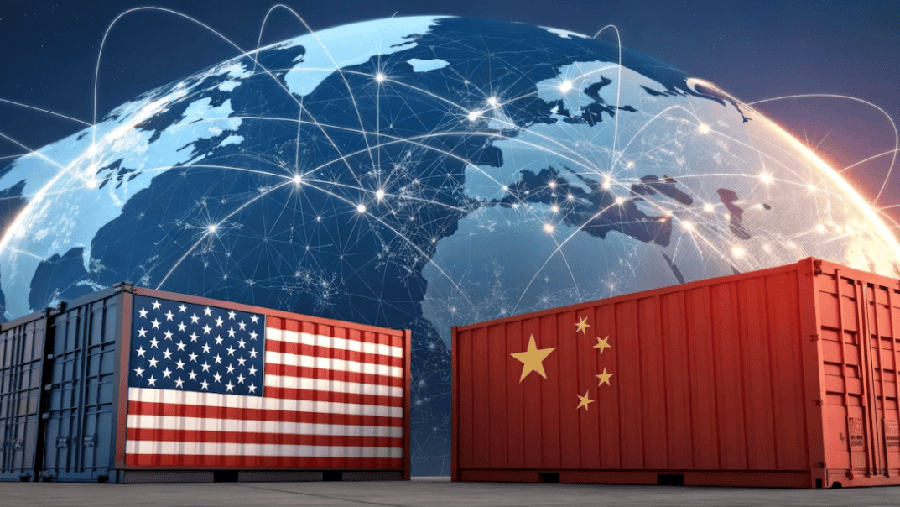President Donald Trump declared the trade war with China “done” on Wednesday, June 11, while U.S. Commerce Secretary Howard Lutnick said tariffs on Chinese goods will be locked in at the current 55 percent rate without additional increases.
“Our deal with China is done, subject to final approval with President Xi and me,” Trump said on Truth Social. “Full magnets and any necessary rare earths will be supplied, up front, by China. Likewise, we will provide to China what was agreed to, including Chinese students using our colleges and universities (which has always been good with me!). We are getting a total of 55 percent tariffs; China is getting 10 percent.”
White House officials told CNBC that the 55 percent tariff mentioned in Trump’s social media post comes from the stacking of the Chinese tariffs. This is the minimum rate being paid by U.S. shippers.
A White House official told the Wall Street Journal that the 55 percent represents the sum of a baseline 10 percent “reciprocal” tariff Trump has imposed on goods imported from nearly all U.S. trading partners; 20 percent on all Chinese imports because of punitive measures Trump has imposed on China, Mexico and Canada, associated with his accusation that the three facilitate the flow of the opioid fentanyl into the U.S.; and pre-existing 25 percent levies on imports from China that were put in place during Trump’s first term in the White House.
Many specifics of the deal and details on how it will be implemented remain unclear.
The deal also reportedly removes Chinese export restrictions on rare earth minerals, although subsequent reports indicated that China would only loosen restrictions for a six-month period. The deal also reportedly allows Chinese students access to U.S. universities. The U.S. is expected to relax new limits that it placed on its exports of technology and products.
Trump’s 55 percent tariff also seems to imply that there isn’t a near-term plan to roll back the 20 percent tariff imposed on China for enabling the flow of fentanyl and related precursors. Beijing had raised the possibility of a full-fledged effort to combat fentanyl ahead of U.S.-China trade talks in Geneva last month.
Secretary of Commerce Howard Lutnick referred to the agreement as a “handshake for a framework.” Presidents Trump and Xi Jinping will now have to approve the framework, Lutnick said. That step would appear to mean there were some concessions that both leaders did not give their negotiating teams authority to negotiate away.
“Once that’s done, we will be back on the phone together and we will begin to implement this agreement,” Lutnick said. “The two largest economies in the world have reached a handshake for the framework.”
The development comes after two days of meetings between negotiators in London and after a phone call last week between Trump and Chinese President Xi Jinping broke a standoff that had flared just weeks after a preliminary deal was reached in Geneva. The U.S. and China announced a 90-day détente that involved reduced tariffs in May, but both sides accused each other of violating the deal.
The administration has pointed to the strength of the U.S. economy and limited inflation to argue that even very high tariffs on Chinese imports have had few negative effects. However, economists and retail trade groups still see the tariffs as only driving prices higher for consumers in the coming months and posing a recession risk.
The World Bank on Tuesday slashed its global growth forecast for 2025 by four-tenths of a percentage point to 2.3 percent, citing higher tariffs and heightened uncertainty posed a “significant headwind” for nearly all economies.
“A reported 55 percent tariff on our largest supplier of American apparel and footwear, stacked on top of already high MFN and Section 301 rates, is not a win for America,” Steve Lamar, CEO of the American Apparel and Footwear Association, told CNBC. “We’re closely watching for more details, but the reality is this: Nearly all clothes and shoes sold in the U.S. are now subject to elevated tariff rates. These costs will hit American families hard, especially as they get ready for back-to-school shopping and the holiday season. New trade deals that bring lower tariffs can’t come soon enough.”
China on Thursday affirmed a trade deal.
“China has always kept its word and delivered results,” Lin Jian, a foreign ministry spokesperson, said at a regular news conference, according to Reuters. “Now that a consensus has been reached, both sides should abide by it.”
















